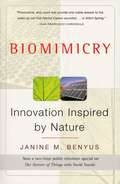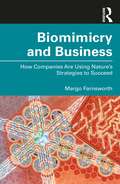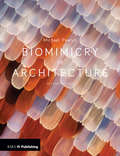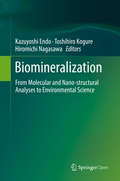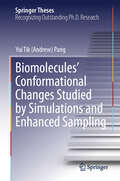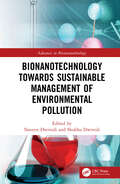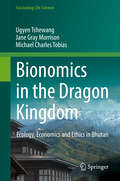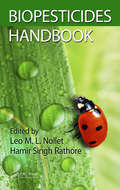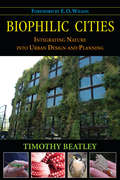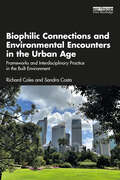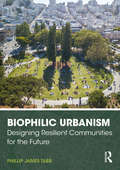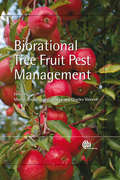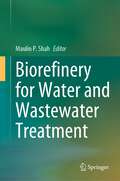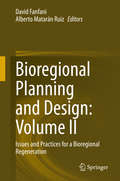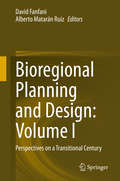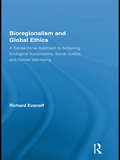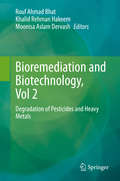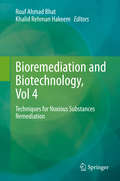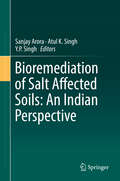- Table View
- List View
Biomimicry
by Janine M. BenyusThis profound and accessible book details how science is studying nature's best ideas to solve our toughest 21st-century problems. If chaos theory transformed our view of the universe, biomimicry is transforming our life on Earth. Biomimicry is innovation inspired by nature - taking advantage of evolution's 3.8 billion years of R&D since the first bacteria. Biomimics study nature's best ideas: photosynthesis, brain power, and shells - and adapt them for human use. They are revolutionising how we invent, compute, heal ourselves, harness energy, repair the environment, and feed the world. Science writer and lecturer Janine Benyus names and explains this phenomenon. She takes us into the lab and out in the field with cutting-edge researchers as they stir vats of proteins to unleash their computing power; analyse how electrons zipping around a leaf cell convert sunlight into fuel in trillionths of a second; discover miracle drugs by watching what chimps eat when they're sick; study the hardy prairie as a model for low-maintenance agriculture; and more.
Biomimicry and Business: How Companies Are Using Nature's Strategies to Succeed
by Margo FarnsworthBiomimicry, the practice of observing then mimicking nature’s strategies to solve business challenges, offers a path to healthy profit while working in partnership, and even reciprocity, with the natural world. Other books have described biomimicry, its uses, and its benefits. This book shows readers how to create their own biomimetic or bioinspired solutions with clear benefits to the bottom line, the environment, and people. Fashioned through storytelling, this book blends snapshots of five successful companies – Nike, Interface, Inc., PAX Scientific, Sharklet Technologies, and Encycle – which decided to partner with nature by deploying biomimicry. The book details how they discovered the practices, introduced them to staff, engaged in the process, and measured outcomes. The book concludes with challenges for readers to determine their own next steps in business and offers practical and useful resources to get there. By revealing the stories of each professional’s journey with lessons they learned, then providing resources and issuing a challenge and pathway to do business better, this book serves as a tool for entrepreneurs, seasoned professionals, and students to emulate nature’s brilliance, apply it at work, and contribute to a healthier, more prosperous world.
Biomimicry in Architecture
by Michael PawlynWhen searching for genuinely sustainable building design and technology - designs that go beyond conventional sustainability to be truly restorative - we often find that nature got there first. Over 3.5 billion years of natural history have evolved innumerable examples of forms, systems, and processes that can be applied to modern green design. For architects, urban designers and product designers, this new edition of Biomimicry in Architecture looks to the natural world to achieve radical increases in resource efficiency. Packed with case studies predicting future trends, this edition also contains updated and expanded chapters on structures, materials, waste, water, thermal control and energy, as well as an all-new chapter on light. An amazing sourcebook of extraordinary design solutions, Biomimicry in Architecture is a must-read for anyone preparing for the challenges of building a sustainable and restorative future.
Biomineralization: From Molecular and Nano-structural Analyses to Environmental Science
by Kazuyoshi Endo Toshihiro Kogure Hiromichi NagasawaThis open access book is the proceedings of the 14th International Symposium on Biomineralization (BIOMIN XIV) held in 2017 at Tsukuba. Over the past 45 years, biomineralization research has unveiled details of the characteristics of the nano-structure of various biominerals; the formation mechanism of this nano-structure, including the initial stage of crystallization; and the function of organic matrices in biominerals, and this knowledge has been applied to dental, medical, pharmaceutical, materials, agricultural and environmental sciences and paleontology. As such, biomineralization is an important interdisciplinary research area, and further advances are expected in both fundamental and applied research.
Biomolecules' Conformational Changes Studied by Simulations and Enhanced Sampling (Springer Theses)
by Yui Tik PangThis thesis illuminates the critical roles biomolecules, from small molecules to proteins, play in cellular functionality, particularly highlighting their conformational changes in response to environmental cues or binding events—a cornerstone concept in drug design as well as the manifestations of disease. It explores the conformational flexibility of small molecules and proteins, essential for predicting drug interactions and understanding biological processes. Through advanced molecular dynamics simulations and enhanced sampling techniques, this research offers unprecedented insights into the structural dynamics of three distinct biomolecular systems: the capsid assembly modulator AT130, the passenger domain of pertactin, and the SARS-CoV-2 spike protein. Each system represents a unique facet of biological complexity, underscoring the thesis's contribution to our understanding of biomolecular behavior across various scales. Furthermore, the thesis advances the field by updating the Force Field Toolkit for improved simulation accuracy. This work not only showcases the adaptability and importance of simulation techniques in modern biological research but also paves the way for novel therapeutic strategies by deepening our understanding of biomolecular dynamics.
Bionanotechnology Towards Sustainable Management of Environmental Pollution (Advances in Bionanotechnology)
by Naveen Dwivedi Shubha DwivediThis book highlights the characteristics, aims, and applications of bionanotechnology as a possible solution for sustainable management and bioremediation of environmental pollutants. It covers remediation of toxic pollutants, removal of emerging contaminants from industrial wastewater, eco-design and modification study of bio-nanoparticles and life-cycle assessment, nano-filtration, bio-nanomaterials based sensors for monitoring air and water pollution, resource recovery from wastewater, and highlights Internet of things-based green nanotechnology.Provides a comprehensive solution of environmental problems in sustainable and cost-effective modeReviews bionanotechnological applications in nanomaterials design, modification, and treatment of emerging contaminants from industrial wastewater.Covers Eco-design study of bio-nanomaterials, bio-nano filters, and assessment for the treatment of emerging pollutantsIncludes IoT- based bionanotechnologyExplores future research needs on bionanotechnology and scientific challenges in the mitigation of environmental pollutantsThis book is aimed at researchers, professionals, and graduate students in nanobiotechnology, environmental engineering, biotechnology.
Bionic Bling
by Rachel CraftArtificial replacement joints have to be tough and extra smooth. That’s why doctors use replacement joints made with the same long-lasting and strong stuff as sapphires and rubies, a natural mineral called alumina. Learn more about why this gemstone is perfect for making new joints!
Bionomics in the Dragon Kingdom: Ecology, Economics and Ethics in Bhutan (Fascinating Life Sciences)
by Michael Charles Tobias Jane Gray Morrison Ugyen TshewangThis compact and elegant work (equally fitting for both academic as well as the trade audiences) provides a readily accessible and highly readable overview of Bhutan’s unique opportunities and challenges; all her prominent environmental legislation, regulatory statutes, ecological customs and practices, both in historic and contemporary terms. At the same time, Bionomics places the ecological context, including a section on animal rights in Bhutan, within the nation’s Buddhist spiritual and ethical setting. Historic contextualization accents the book’s rich accounting of every national park and scientific reserve, as well as providing up-to-the-minute climate-change related hurdles for the country.Merging the interdisciplinary sciences, engineering and humanities data in a compelling up-to-date portrait of the country, the authors have presented this dramatic compendium against the backdrop of an urgent, global ecological time-frame. It thus becomes clear that the articulated stakes for Bhutan, like her neighboring Himalayan and Indian sub-continental countries (China, India, Bangladesh and Myanmar) are immense, as the Anthropocene epoch unfolds, affecting every living being across the planet. Because Bhutan’s two most rewarding revenue streams derive from the sale of hydro-electric power and from tourism, the complexities of modern pressures facing a nation that prides herself on maintaining traditional customs in what has been a uniquely isolated nation are acute.
Biopesticides Handbook
by Hamir Singh Rathore Leo M. L. NolletThe need to feed an ever-growing global population combined with increasing demand for sustainable agricultural practices has generated a significant rise in demand for biopesticides. By responding concurrently to the interests of farming, forestry, and industrial sectors, biopesticides offer a considerable potential for utilization in sustainable
Biophilic Cities for an Urban Century: Why nature is essential for the success of cities
by Timothy Beatley Robert McDonaldThis book argues that, paradoxically, at their moment of triumph and fastest growth, cities need nature more than ever. Only if our urban world is full of biophilic cities will the coming urban century truly succeed. Cities are quintessentially human, the perfect forum for interaction, and we are entering what could justly be called the urban century, the fastest period of urban growth in human history. Yet a growing body of scientific literature shows that the constant interaction, the hyper-connectedness, of cities leads to an urban psychological penalty. Nature in cities can be solution to this dilemma, allowing us to have all the benefits of our urban, connected world yet also have that urban home be a place where humanity can thrive. This book presents best practices and case studies from biophilic design, showing how cities around the world are beginning to incorporate nature into their urban fabric. It will be a valuable resource for scholars and professionals working in the area of sustainable cities.
Biophilic Cities: Integrating Nature into Urban Design and Planning (Cities And The Global Politics Of The Environment Ser.)
by Timothy BeatleyTim Beatley has long been a leader in advocating for the "greening" of cities. But too often, he notes, urban greening efforts focus on everything except nature, emphasizing such elements as public transit, renewable energy production, and energy efficient building systems. While these are important aspects of reimagining urban living, they are not enough, says Beatley. We must remember that human beings have an innate need to connect with the natural world (the biophilia hypothesis). And any vision of a sustainable urban future must place its focus squarely on nature, on the presence, conservation, and celebration of the actual green features and natural life forms. A biophilic city is more than simply a biodiverse city, says Beatley. It is a place that learns from nature and emulates natural systems, incorporates natural forms and images into its buildings and cityscapes, and designs and plans in conjunction with nature. A biophilic city cherishes the natural features that already exist but also works to restore and repair what has been lost or degraded. In Biophilic Cities Beatley not only outlines the essential elements of a biophilic city, but provides examples and stories about cities that have successfully integrated biophilic elements--from the building to the regional level--around the world. From urban ecological networks and connected systems of urban greenspace, to green rooftops and green walls and sidewalk gardens, Beatley reviews the emerging practice of biophilic urban design and planning, and tells many compelling stories of individuals and groups working hard to transform cities from grey and lifeless to green and biodiverse.
Biophilic Connections and Environmental Encounters in the Urban Age: Frameworks and Interdisciplinary Practice in the Built Environment
by Richard Coles Sandra CostaBiophilic Connections and Environmental Encounters in the Urban Age takes a multi-disciplinary approach, drawing on the authors’ wide range of experience, to provide a greater understanding of the different dimensions of environmental engagement. It considers the ways that we interact with our environments, presenting a comprehensive account of how people negotiate and use the urban landscape. Set within current debates concerning urban futures, societal issues, sustainable cities, health and well-being, the book explores our innate need for contact with the natural world through biophilic design thinking to expand our knowledge base and promote a wider understanding of the importance of these interactions on our collective well-being. It responds to questions such as, what are the urban qualities that support our well-being? As an urbanised society what are the environmental determinants that promote healthy and satisfying lifestyles? Beginning with an overview of concepts relating to biophilia and environmental engagement, it moves through current theory and practice, different pathways and their characteristics, before presenting real world examples and applications through illustrated case studies in different world situations. With a particular focus on the experience of individuals, the book is essential reading for students, researchers, and practitioners of architecture, landscape architecture, urban planning, design and health sciences, interested in the future of our cities and the importance of green spaces.
Biophilic Urbanism: Designing Resilient Communities for the Future
by Phillip James TabbBiophilic Urbanism provides readers with the tools to create more nature-based urban environments that are climate positive, sustainable, and healthy. The principles of biophilia are intended to support appreciation and direct engagement with nature, to responsibly utilize on-site natural resources, and to plan according to climatic conditions and local ecological processes. It seeks to create resilient and equitable human places capable of providing critical life-support functions and a strong sense of community, and to foster experiences that raise the human spirit creating a sense of awe. Twenty-five pattern attributes are defined and explored, each of which contributes to these goals. Because of the dire necessity to respond to the COVID-19 pandemic, Biophilic Urbanism includes discussion of our need for connections, both to nature and one another, and the physical characteristics of cities and buildings relative to the contagious qualities of the air-borne virus. Case studies, found throughout the world, are presented illustrating detailed biophilic planning and design strategies. The book will be of use to practitioners and students in the fields of natural and social sciences, behavioral science and psychology, environmental engineering, health and wellness professionals, architecture, landscape architecture, interior architecture, and planning.
Biophysical Applications of Satellite Remote Sensing (Springer Remote Sensing/Photogrammetry)
by Jonathan M. HanesA variety of biophysical applications (e. g. leaf area index and gross primary productivity) have been derived from measurements of the Earth system obtained remotely by NASA's MODIS sensors and other satellite platforms. In Biophysical Applications of Satellite Remote Sensing, the authors describe major applications of satellite remote sensing for studying Earth's biophysical phenomena. The focus of the book lies on the broad palette of specific applications (metrics) of biophysical activity derived using satellite remote sensing. With in-depth discussions of satellite-derived biophysical metrics that focus specifically on theory, methodology, validation, major findings, and directions of future research, this book provides an excellent resource for remote sensing specialists, ecologists, geographers, biologists, climatologists, and environmental scientists.
Biophysical Economy: Theory, Challenges, and Sustainability (Applied Ecology and Environmental Management)
by Steven M. BartellThis book explores the concept of transforming the current macroeconomic system from one based on continuous growth that doesn’t recognize the fundamental importance of Earth's natural support structures, to a system consistent with the basic views of biophysical economics that acknowledges that all real wealth ultimately derives from planetary resources, both renewable and non-renewable. It describes how data and information collected by various institutions, government agencies, and the private sector can be integrated with existing management structures to transform the “continuous growth” economy into an economy that functions within understandable boundaries on a finite planet. Features Stimulates discussions of the feasibility of a biophysical economy. Discusses the historical developments of biophysical economics. Offers a practical approach to building a biophysical economy. Explores the human experience of living in a biophysical economy. Emphasizes the fragility of life in the Universe as we know it. This book is an excellent resource for academics and students studying sustainable development, as well as for professionals working in the private sector and public institutions with an interest in economic planning for a sustainable future.
Biorational Tree Fruit Pest Management
by Martin Aluja Tracy C. Leskey Charles VincentFocusing on insect pests of tree fruits and combining behavioral research with crop protection applications, this book emphasizes the importance of environmentally sustainable approaches in an agricultural ecosystem.
Biorefinery for Water and Wastewater Treatment
by Maulin P. ShahBio-refinery approach of microbial fermentation, production of biogas, bioenergy, enzymes, bioactive molecules, agricultural nutrient and many more, which is presently restricted to specific journals, review articles and research papers in conference proceedings. Hence, my effort is to provide a complete and globally available advance knowledge in wastewater treatment with an aim of recovery of value added products. This will help in designing new approaches of waste water treatment with this value added thoughts. Thus, it will be a boon for a concern broad range of readers and industry professionals to their means of technology development for pollution prevention and economic growth of the country.
Bioregional Planning and Design: Issues and Practices for a Bioregional Regeneration
by David Fanfani Alberto Matarán RuizThis book provides insights and discusses the practical application of the theoretical concept of urban bioregion complementing the general bio-regional planning cross-disciplinary issues provided in Volume I. It examines planning practices, such as relocalisation of energy flows, land protection for climate change, territorial heritage enhancement, the consideration of urban ecosystems and agro-ecology. It presents discussions on regional contexts, practices and projects for a bioregional recovery, and includes case studies from France, Belgium, Spain, Greece, Austria and Italy, discussing topics that range from the reframing of local energy production/delivery planning systems to soil protection and farmland sustainable exploitation schemes. This volume concludes with three cross-European case studies that make clear the worldwide relevance and potential of bioregional approach beyond the Global North or Western countries.
Bioregional Planning and Design: Perspectives on a Transitional Century
by David Fanfani Alberto Matarán RuizThis book provides a review of the bioregionalist theory in the field of spatial planning and design as a suitable approach to cope with the growing concerns about the negative effects of metropolization processes and the need for a sustainable transition. The book starts out with a section on rethinking places for community life, and discusses the reframing of regional governance and development as well as social justice in spatial planning. It introduces the concept of the urban bioregion, a pivotal concept that underpins balanced polycentric spatial patterns and supports self-reliant and fair local development. The second part of the book focuses on planning, and particularly on the issues that arise from the ‘circular’ recovery of the relation between city and agro-ecosystems for integrated planning and resilience of settlements and discusses topics such as foodshed planning, biophilic urbanism and the integration of rural development and spatial planning. This volume sets out the reference framework for Volume II which deals with more specific and operational issues related to spatial policies and settlement design.
Bioregionalism
by Michael Vincent McGinnisBioregionalism is the first book to explain the theoretical and practical dimensions of bioregionalism from an interdisciplinary standpoint, focusing on the place of bioregional identity within global politics. Leading contributors from a broad range of disciplines introduce this exciting new concept as a framework for thinking about indigenous peoples, local knowledge, globalization, science, global environmental issues, modern society, conservation, history, education and restoration. Bioregionalism's emphasis on place and community radically changes the way we confront human and ecological issues.
Bioregionalism and Global Ethics: A Transactional Approach to Achieving Ecological Sustainability, Social Justice, and Human Well-being
by Richard EvanoffWhile a number of schools of environmental thought — including social ecology, ecofeminism, ecological Marxism, ecoanarchism, and bioregionalism — have attempted to link social issues to a concern for the environment, environmental ethics as an academic discipline has tended to focus more narrowly on ethics related either to changes in personal values or behavior, or to the various ways in which nature might be valued. What is lacking is a framework in which individual, social, and environmental concerns can be looked at not in isolation from each other, but rather in terms of their interrelationships. In this book, Evanoff aims to develop just such a philosophical framework — one in which ethical questions related to interactions between self, society, and nature can be discussed across disciplines and from a variety of different perspectives. The central problem his study investigates is the extent to which a dichotomized view of the relationship between nature and culture, perpetuated in ongoing debates over anthropocentric vs. ecocentric approaches to environmental ethics, might be overcome through the adoption of a transactional perspective, which offers a more dynamic and coevolutionary understanding of how humans interact with their natural environments. Unlike anthropocentric approaches to environmental ethics, which often privilege human concerns over ecological preservation, and some ecocentric approaches, which place more emphasis on preserving natural environments than on meeting human needs, a transactional approach attempts to create more symbiotic and less conflictual modes of interaction between human cultures and natural environments, which allow for the flourishing of both.
Bioremediation and Biotechnology, Vol 2: Degradation of Pesticides and Heavy Metals
by Khalid Rehman Hakeem Rouf Ahmad Bhat Moonisa Aslam DervashThis book addresses the grave concerns stemming out due to conventional treatment techniques. The main focus of this book revolves round the central kernel of novel technology (bioremediation and biotechnology) which has emerged as an independent warrior to clean up and restore the disturbed environs. Furthermore, this book is a coherent assortment of diverse chapters relevant to the role of biotechnology and bioremediation for restoration of the ecosystems degraded by pesticide and heavy metal pollution. The inaugural chapters deal with the quantification of problem and its magnitude due to pesticides and heavy metals, followed by innovative modern biotechnological and bioremediation treatment technologies and sustainable techniques to remediate the persistent pollutants. It is a detailed comprehensive account for the treatment technologies from unsustainable to sustainable. Academicians, researchers and students shall find it as a complete wrap up regarding biotechnological intervention for sustainable treatment of pollution and shall suffice for the diverse needs of teaching and research.
Bioremediation and Biotechnology, Vol 3: Persistent and Recalcitrant Toxic Substances
by Khalid Rehman Hakeem Rouf Ahmad Bhat Najla Bint Saud Al-SaudHealthy environment is important for any kind of biota on earth. It provides the basic elements of life such as clean water, fresh air, fertile soil and supports ecosystem of the food chain. Pollution drastically alters quality of the environment by changing the physico-chemical and biological aspects of these components. Accordingly, toxic metals, combustible and putrescible substances, hazardous wastes, explosives and petroleum products are all examples of inorganic and organic compounds that cause contaminations. Specifically, pollution of toxic and heavy metal in the environment is a growing problem worldwide, currently at an alarming rate. Toxic metals threaten the aquatic ecosystems, agriculture and ultimately human health. Traditional treatment techniques offer certain advantages such as rapid processing, ease of operation and control and flexibility. But, they could not maintain the quality of the environment due to the high operational costs of chemicals used, high energy consumption and handling costs for sludge disposal and overburden of chemical substances which irreversibly affect and destroy biodiversity, which ultimately render the soil useless as a medium for plant growth. Therefore, bioremediation and biotechnology, carried out by living assets to clean up, stabilize and restore contaminated ecosystems, have emerged as promising, environmental friendly and affordable approaches. Furthermore, the use of microbes, algae, transgenic plants and weeds adapted to stressful environments could be employed to enhance accumulation efficiency. Hence, sustainable and inexpensive processes are fast emerging as a viable alternative to conventional remediation methods, and will be most suitable for developing countries.In the current volume, we discuss pollution remediation challenges and how living organisms and the latest biotechnological techniques could be helpful in remediating the pollution in ecofriendly and sustainable ways.
Bioremediation and Biotechnology, Vol 4: Techniques for Noxious Substances Remediation
by Khalid Rehman Hakeem Rouf Ahmad BhatThe rapid thriving of industries, conversion of agricultural land to residential areas, habitat destruction, deforestation and use of recalcitrant synthetic substances enhanced the rate of degradation of the environment. Although there are various conventional techniques for degradation and cleaning of noxious pollutants from disturbed environs, they are energy inefficient and costly to install. Bioremediation has emerged recently as an alternative and novel approach to manage and control environmental pollutants. This volume focuses explicitly on the remediation of noxious substances in stressed environs. It includes expert-contributed chapters on bio-monitoring by way of evaluating the relationship of biota with the polluted/stressed environs, sustainable plant-based degradation of noxious pollutants, and the application of biotechnologies to achieve tailored responses.Academicians, researchers, scientists and students will find this work essential for sustainable treatment of noxious pollutants. This book also serves as a core guide for training, teaching and research in conservation biology and environmental rehabilitation.
Bioremediation of Salt Affected Soils: An Indian Perspective
by Sanjay Arora Atul K. Singh Y. P. SinghThis edited volume focuses on the characterization, reclamation, bioremediation, and phytoremediation of salt affected soils and waterlogged sodic soils. Innovative technologies in managing marginal salt affected lands merit immediate attention in the light of climate change and its impact on crop productivity and environment. The decision-making process related to reclamation and management of vast areas of salt affected soils encompasses consideration of economic viability, environmental sustainability, and social acceptability of different approaches. The chapters in this book highlight the significant environmental and social impacts of different ameliorative techniques used to manage salt affected soils. Readers will discover new knowledge on the distribution, reactions, changes in bio-chemical properties and microbial ecology of salt affected soils through case studies exploring Indian soils. The contributions presented by experts shed new light on techniques such as the restoration of degraded lands by growing halophyte plant species, diversification of crops and introduction of microbes for remediation of salt infested soils, and the use of fluorescent pseudomonads for enhancing crop yields.
